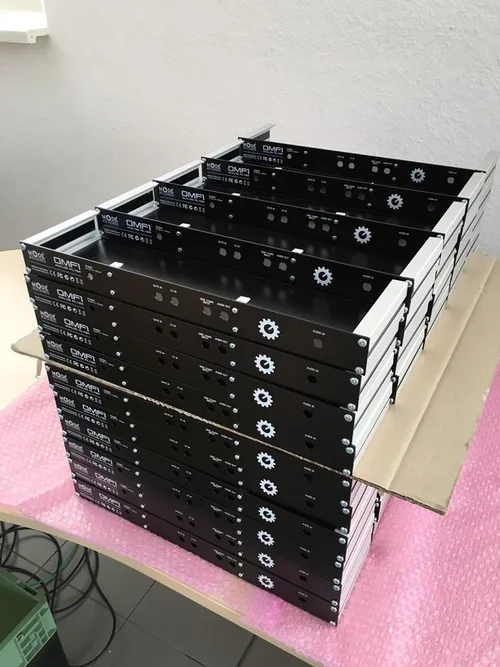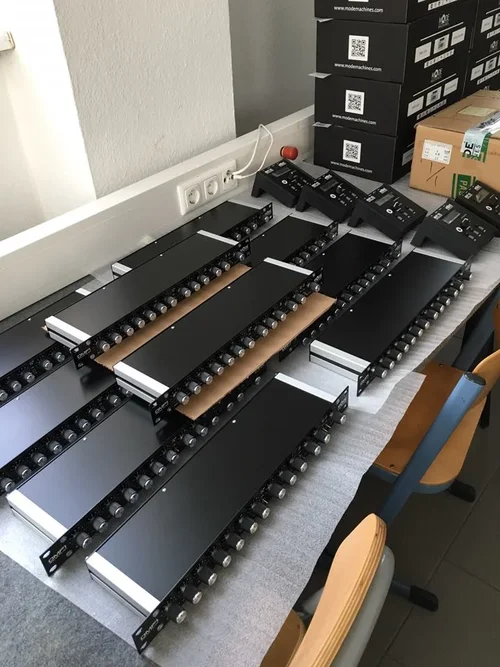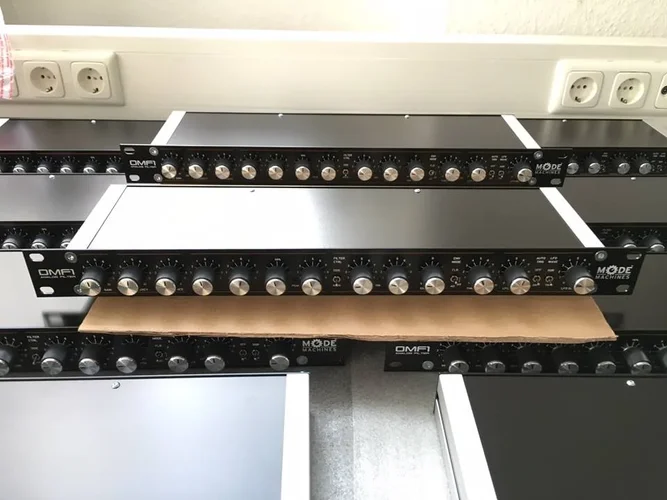citric acid
|||||||||||
Hallo,
da ich in einem anderen Post gefragt wurde mal das Filter zu zeigen, welches ich zum Test von Mode Machines bekommen habe, wollte ich Euch diese Videos nicht vorenthalten. Ich finde es grade zum an zerren von sounds und samples echt top. Besonders für Tb 303
Ich habe ganz quick and Dirty mal einen Yamaha Reface und eine TB 303 durch gejagt .
Bei der TB 303 habe ich auch die CV und gate Ausgänge der TB genutzt um das filter zu steuern.
Ich war sehr überrascht von der sehr guten Qualität des Gerätes. Sehr gut verbaut und schöne Poti.
Das Gerät ist ein Oakley Filter, welches in Lizenz von Mode Machines gebaut wird.
Es hat ein paar CV und Gate & Side Chain Möglichkeiten.
Hier meine Videos:
Hier mal der Text der Mode Machines Page:
OMF-1
OMF1_Side (1)Rack Mountable Analogue Filter:
The Mode Machines OMF-1 contains:
A four pole true analogue filter. This is based on the famous transistor ladder filter developed by Dr Bob Moog in the 1960s. A front panel pot controls the filter cut-off frequency, another controls the resonance. The resonance control is configured not to cause volume drop when turned up. The filter can be made to oscillate if required.
Two filter outputs are available. One is the Fizz output. This is a type of -6dB/octave filter and it gives a unique filtering effect with a real bite. The other is the Smooth output. This is a classic -24dB/octave filter, and gives a smooth warm analogue filter sound. Each filter output goes via its own reversible attenuator. This means not only can you adjust the output level, but also the phase of the output signal. This allows complex filter shapes to be made when the two outputs are mixed together in various degrees. This includes a very nice sounding band pass filter.
A wet/dry control allows the filtered audio to be mixed with the original signal. Not only is this useful in controlling the depth of the effect, but it can also create unusual phasing and vibrato type effects.
A wide range pre-amplifier is included. You can use the OMF-1 with virtually any input from guitars to synthesisers. A peak indicator will allow you to monitor overloads, although the OMF-1 is designed to overdrive beautifully.
An inbuilt low frequency oscillator with triangle and square waveforms. The frequency can be changed from 0.05Hz (one cycle in 20 seconds) to over 50Hz. A bi-colour LED gives visual indication of the speed of the LFO. Use the LFO to create auto wah and phaser type effects. The LFO can also be selected to trigger the envelope generator.
An ingenious dynamic envelope section that can move the filter cut off point up or down. It can be put into one of three modes at a flick of a switch:
FLR: It can function as a useful envelope follower, with controllable attack and decay times. Perfect for simulating many classic dynamic follower filter boxes. Play louder and hear the filter open up.
AD: It can be a standard attack-decay envelope generator. This is a type of one shot envelope, that rises and falls at the presence of an initial trigger signal. Useful for percussive type sounds.
AR: It can be a standard attack-release envelope generator. This is triggered either by the LFO, external gate signal or by an automatic audio trigger circuit with a variable threshold level. Powerful for creating rising crescendos.
The final output volume can be controlled with a level control. The output circuitry is configured to drive long length cables with ease and without ground loops.
A side chain input is available. This is a second audio input that can control the main input, but is not heard directly. Use this to trigger the envelope generator, or drive the envelope follower. A common use of this is to make the main audio program respond to a drum machine’s output for syncopated effects. Use a deep rich string patch as your main input, and listen to the drum machine automatically pulse the output to the beat. Awesome!
CV and gate inputs are available for connection to a modular synth or midi-CV convertor. The CV input will control the filter frequency, and the gate control will trigger the envelope generator if selected.
With a second OMF-1 a stereo unit may be built. The two channels can either be run independantly or linked together for true stereo processing.
•True analog classic filter.
•13 knobs & 4 switches for direct acces to all the parameters.
•Audio In-/Out 6,3 mm Jacks.
•Dimensions: Standard 1U Rack.
•Robust metal chassis.
•Weight: 2kg
•PSU: 15V – 18V AC wallwart included.
Homepage: http://www.modemachines.com/products/catalogue/omf-1/
da ich in einem anderen Post gefragt wurde mal das Filter zu zeigen, welches ich zum Test von Mode Machines bekommen habe, wollte ich Euch diese Videos nicht vorenthalten. Ich finde es grade zum an zerren von sounds und samples echt top. Besonders für Tb 303
Ich habe ganz quick and Dirty mal einen Yamaha Reface und eine TB 303 durch gejagt .
Bei der TB 303 habe ich auch die CV und gate Ausgänge der TB genutzt um das filter zu steuern.
Ich war sehr überrascht von der sehr guten Qualität des Gerätes. Sehr gut verbaut und schöne Poti.
Das Gerät ist ein Oakley Filter, welches in Lizenz von Mode Machines gebaut wird.
Es hat ein paar CV und Gate & Side Chain Möglichkeiten.
Hier meine Videos:
Hier mal der Text der Mode Machines Page:
OMF-1
OMF1_Side (1)Rack Mountable Analogue Filter:
The Mode Machines OMF-1 contains:
A four pole true analogue filter. This is based on the famous transistor ladder filter developed by Dr Bob Moog in the 1960s. A front panel pot controls the filter cut-off frequency, another controls the resonance. The resonance control is configured not to cause volume drop when turned up. The filter can be made to oscillate if required.
Two filter outputs are available. One is the Fizz output. This is a type of -6dB/octave filter and it gives a unique filtering effect with a real bite. The other is the Smooth output. This is a classic -24dB/octave filter, and gives a smooth warm analogue filter sound. Each filter output goes via its own reversible attenuator. This means not only can you adjust the output level, but also the phase of the output signal. This allows complex filter shapes to be made when the two outputs are mixed together in various degrees. This includes a very nice sounding band pass filter.
A wet/dry control allows the filtered audio to be mixed with the original signal. Not only is this useful in controlling the depth of the effect, but it can also create unusual phasing and vibrato type effects.
A wide range pre-amplifier is included. You can use the OMF-1 with virtually any input from guitars to synthesisers. A peak indicator will allow you to monitor overloads, although the OMF-1 is designed to overdrive beautifully.
An inbuilt low frequency oscillator with triangle and square waveforms. The frequency can be changed from 0.05Hz (one cycle in 20 seconds) to over 50Hz. A bi-colour LED gives visual indication of the speed of the LFO. Use the LFO to create auto wah and phaser type effects. The LFO can also be selected to trigger the envelope generator.
An ingenious dynamic envelope section that can move the filter cut off point up or down. It can be put into one of three modes at a flick of a switch:
FLR: It can function as a useful envelope follower, with controllable attack and decay times. Perfect for simulating many classic dynamic follower filter boxes. Play louder and hear the filter open up.
AD: It can be a standard attack-decay envelope generator. This is a type of one shot envelope, that rises and falls at the presence of an initial trigger signal. Useful for percussive type sounds.
AR: It can be a standard attack-release envelope generator. This is triggered either by the LFO, external gate signal or by an automatic audio trigger circuit with a variable threshold level. Powerful for creating rising crescendos.
The final output volume can be controlled with a level control. The output circuitry is configured to drive long length cables with ease and without ground loops.
A side chain input is available. This is a second audio input that can control the main input, but is not heard directly. Use this to trigger the envelope generator, or drive the envelope follower. A common use of this is to make the main audio program respond to a drum machine’s output for syncopated effects. Use a deep rich string patch as your main input, and listen to the drum machine automatically pulse the output to the beat. Awesome!
CV and gate inputs are available for connection to a modular synth or midi-CV convertor. The CV input will control the filter frequency, and the gate control will trigger the envelope generator if selected.
With a second OMF-1 a stereo unit may be built. The two channels can either be run independantly or linked together for true stereo processing.
•True analog classic filter.
•13 knobs & 4 switches for direct acces to all the parameters.
•Audio In-/Out 6,3 mm Jacks.
•Dimensions: Standard 1U Rack.
•Robust metal chassis.
•Weight: 2kg
•PSU: 15V – 18V AC wallwart included.
Homepage: http://www.modemachines.com/products/catalogue/omf-1/



